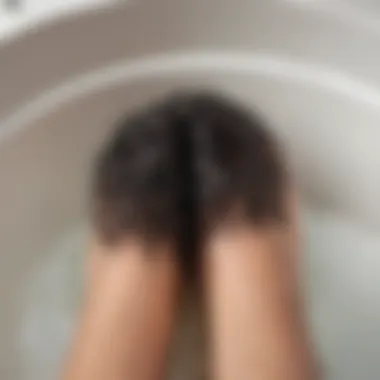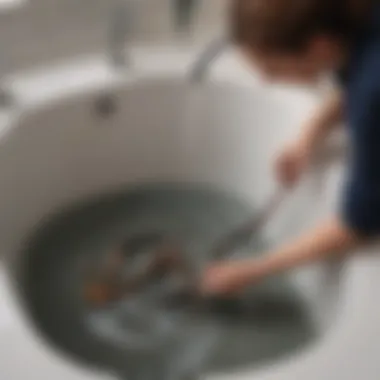Unclog Your Tub Drain: Effective Hair Removal Strategies


Intro
Maintaining a clear tub drain is essential for both functionality and aesthetics. A clogged drain, particularly one obstructed by hair, is a common issue in many households. It can lead to water pooling in the tub and create an unsightly mess. Understanding the causes and methods of unclogging is crucial for homeowners.
In this article, we will explore effective strategies to deal with hair clogs in tub drains. The focus will be on both preventive measures to avoid such situations and practical solutions for when a clog occurs. By following the guidance in this article, homeowners can enhance their living space and ensure optimal plumbing functionality.
Homeowners may often overlook the importance of maintaining tub drains. However, neglecting this aspect can result in more significant plumbing problems and costly repairs. Let's dive deeper into the features of our homes that can contribute to these issues.
Understanding Hair Clogs in Tub Drains
Understanding hair clogs in tub drains is essential for homeowners who wish to maintain a functional and clean bathing environment. Hair is one of the most common substances that contribute to drain obstructions. Recognizing the nature and causes of these clogs can enable homeowners to implement effective preventative measures and select the most suitable unclogging techniques when necessary.
The Nature of Hair Clogs
Hair clogs develop when strands of hair accumulate in the drain over time. This can create significant blockages, impeding water flow. Unlike other materials that may dissolve or break down, hair tends to tangle and mat with other debris. This combination creates a relatively stubborn obstruction. The density of the clog can make it more challenging to clear, especially when left unattended for long periods.
Factors like hair length, texture, and the frequency of use significantly influence how quickly a clog forms. For instance, longer hair can gather more easily and entangle with soap residue, skin cells, and mineral deposits, creating a more severe blockage.
Common Causes of Hair Accumulation
Hair accumulation is often caused by a variety of habits and conditions.
- Regular Bathing and Hair Washing: Frequent washing of hair leads to the release of loose strands into the drain.
- Product Use: The use of soaps, conditioners, and other hair products can contribute to build-up alongside hair.
- Improper Drain Covers: Lack of or malfunctioning drain covers allows hair to enter the drain unimpeded.
- Bathroom Design: Features like whirlpool tubs can create turbulent water flow, causing hair to swirl and eventually block the drain.
Familiarity with these causes helps in identifying when hair clogs may develop and how to actively manage them, ultimately preserving plumbing functionality and improving the overall hygiene of a home.
Consequences of Clogged Tub Drains
Clogged tub drains, particularly those hindered by hair, can have far-reaching implications. Understanding these consequences is essential for homeowners and renters alike. Recognizing the importance of addressing these issues promptly fosters a proactive approach towards plumbing maintenance and home care. Not only does it alleviate immediate discomfort, but it also mitigates costly repairs in the future.
Impact on Plumbing Systems
When hair accumulates in a tub drain, it does not merely obstruct water flow; it can lead to serious plumbing issues. Hair mixes with soap residue and other materials, forming dense clogs that can be challenging to remove. Over time, this buildup can cause water to drain slower than usual. If left unattended, it can lead to full blockages. In these cases, water may overflow, causing potential flooding or water damage to the surrounding areas.
In more severe instances, blockages can strain the entire plumbing system. This can result in increased pressure on pipes, leading to bursts or leaks. Hence, maintaining a clear tub drain is critical in preserving both the efficiency and integrity of a home’s plumbing system. Regular checks can save significant stress and financial outlay associated with repairs or replacements of compromised pipes.
Effects on Home Hygiene
Clogged drains pose hygiene risks that extend beyond mere inconvenience. When water does not drain properly, it can stagnate, creating a perfect breeding ground for bacteria and mold. This situation can lead to unpleasant odors, and health risks, particularly for anyone with respiratory issues or allergies.


Moreover, the standing water in a clogged tub can attract pests such as mosquitoes, which thrive in clean, stagnant water. Homeowners must consider how maintaining clear tub drains impacts overall home hygiene. The wellbeing of residents may be compromised, emphasizing the need for effective strategies to keep drains clear of hair and other debris.
Maintaining a clean tub drain is essential not only for plumbing efficiency but also for the general health of the household.
Understanding these consequences is fundamental for any homeowner who values their living environment. The implications of neglect can range from minor inconveniences to major health concerns and costly plumbing repairs. Taking proactive measures can mitigate these risks and foster a more pleasant living situation.
Preventive Measures to Avoid Hair Clogs
Preventing hair clogs in tub drains is essential for maintaining efficient plumbing and ensuring hygiene in the home. The accumulation of hair can lead to severe blockages over time, which can cause water to drain slowly or not at all. Taking proactive steps can save homeowners from the hassle and expense of major plumbing repairs.
Establishing a routine for drain maintenance helps to make the household plumbing system more resilient against clogs. Moreover, prevention increases the lifespan of the plumbing and enhances the overall functionality of the bathroom. Regular attention to drains can reduce the frequency of interventions required to clear blockages, making it an efficient practice to adopt.
Regular Maintenance Practices
Regular maintenance can significantly reduce the build-up of hair in tub drains. Simple practices such as flushing the drain with hot water once a week can help break down any hair and soap scum that might accumulate. This method is particularly effective as it combines heat with motion to disperse potential clogs.
Additionally, a monthly inspection of the drain for debris or signs of blockage can prevent more significant problems down the road. Homeowners can use a drain snake occasionally to ensure that hair does not have a chance to build up. It's advisable to keep a journal or a checklist of maintenance tasks to track their frequency and effectiveness.
Utilizing Drain Covers and Screens
One of the most effective preventive measures is to install drain covers or screens. These simple devices catch hair and other debris before they enter the drain. Choosing the right size and type for your tub can dramatically decrease the amount of hair that goes down the drain.
Depending on the design, mesh screens can be removed easily for cleaning. Doing so regularly ensures that the collected hair does not back up and create further issues. Investing in a quality drain cover is a small but impactful way to protect your plumbing system from hair clogs.
Key Tip: Changing the drain cover or screen once every few months enhances effectiveness and ensures ease of cleaning.
DIY Methods for Unclogging a Hair-Stopped Tub Drain
Clogs in tub drains, particularly those caused by hair, are a common household issue. Understanding DIY methods for unclogging is vital because it allows homeowners to address the issue quickly and without the need for expensive plumbing services. These methods can save time and money, and they often use readily available tools and materials. Moreover, performing your own unclogging tasks can give a sense of accomplishment and enhance one's home maintenance skills.
Using a Plunger
A plunger is one of the simplest yet most effective tools for clearing clogs. To use a plunger, follow these steps:
- Remove any standing water in the tub to expose the drain opening.
- Ensure a good seal by placing the plunger over the drain and covering it completely.
- Use firm, repeated thrusts. Push down and pull up rapidly to create pressure.
- After several thrusts, lift the plunger and check if the water starts to drain.
Employing a Drain Snake
A drain snake, also known as a plumber's auger, can reach deeper blockages that a plunger cannot. Here’s how to use it effectively:
- Insert the snake into the drain until you feel resistance.
- Turn the handle clockwise to grip the clog.
- Pull back while turning to remove hair and debris caught in the snake.
- Continue until the drain is clear, then run hot water to flush out any remaining bits.


Home Remedies: Baking Soda and Vinegar
For those who seek eco-friendly methods, baking soda and vinegar offer an effective solution:
- Pour half a cup of baking soda down the drain first.
- Follow with half a cup of vinegar and close the drain with a plug.
- Allow it to sit for about 30 minutes.
- Flush with hot water. This reaction helps dissolve hair clogs naturally.
Manual Removal of Hair Clogs
Sometimes, the most straightforward method is manual removal. This approach requires minimal tools. Consider these steps:
- Wear gloves to maintain hygiene.
- Utilize a straightened wire hanger or a specialized drain cleaning tool.
- Carefully insert the tool into the drain and feel for hair.
- Gently pull the hair out. This method is particularly effective for visible clogs.
Using Wet/Dry Vacuum Cleaners
A wet/dry vacuum is another excellent tool for removing hair clogs. Here’s how to employ one:
- Set your vacuum to the liquid setting.
- Cover the vent to maximize suction.
- Place the hose directly above the drain and power it on.
- This powerful suction can pull out the clog, often resulting in immediate drainage.
End
Utilizing these DIY methods can effectively clear hair-stopped tub drains, enhancing plumbing functionality and overall home hygiene. Whether opting for mechanical tools or organic solutions, homeowners have a range of approaches to choose from based on resource availability and personal preference.
When to Seek Professional Help
Clogged tub drains can often seem manageable, especially for homeowners who prefer to tackle issues on their own. However, there are situations where seeking professional help is not just advisable, but necessary. Recognizing when to make this decision can save time, prevent damage, and help restore functionality to your plumbing system.
Signs of Severe Clogging
Identifying the signs of severe clogging can be crucial in determining whether it’s time to call a professional plumber. Here are some indicators you should be aware of:
- Persistent Slow Drainage: If your tub consistently drains slowly despite attempts to clear it, this is a sign that the clog may be more extensive than initially thought. A small accumulation of hair usually resolves easily, but chronic slow drainage often indicates deeper issues.
- Frequent Backups: If water backs up not only in the tub but also in the sink or toilet, this suggests a blockage farther in the plumbing system that requires professional intervention.
- Unpleasant Odors: Foul smells around the drain can be a symptom of decomposition or material buildup. This is not only unpleasant but also can lead to unsanitary conditions if left unattended.
- Multiple Fixtures Affected: If other fixtures, such as sinks or toilets, are also having issues, it indicates a systemic problem. It’s crucial to have this inspected by a professional as DIY methods may only provide temporary relief.
- Visible Signs of Leaking: Water leakage from pipes or fixtures related to the drain can signal serious plumbing issues that require professional attention. Ignoring these signs can lead to costly water damage and mold growth.
If you observe any of these signs, it may be time to consult a plumbing expert.
Choosing the Right Plumbing Service
When it becomes clear that professional assistance is needed, choosing the right plumbing service is vital. Here are several factors to consider:
- Experience and Credentials: Look for a plumbing service with a good track record. Check for licenses and insurance that demonstrates professionalism and expertise. You can often find references online.
- Customer Reviews: Reading reviews on platforms like Reddit or Yelp can provide insights into other customers’ experiences. This information is useful for gauging the reliability and service quality of the company.
- Specialization: Make sure the plumber specializes in drain issues. Some technicians may be experts in heating or remodeling, but not necessarily in drain clearing.
- Availability: Severe drain issues can arise unexpectedly. Choose a service that offers emergency response or quick scheduling.
- Cost Estimates: Be upfront about costs. A reputable plumbing service should provide clear estimates and a breakdown of potential expenses to avoid any surprises later.


Sustainable Practices for Drain Maintenance
Sustainable practices in drain maintenance play a crucial role in preserving both the environment and the effectiveness of plumbing systems. Homeowners often overlook the long-term impact of their choices regarding drain cleaning and maintenance. Using harsh chemicals can lead to serious environmental degradation, and it can affect the health of plumbing infrastructure.
Adopting sustainable techniques not only improves the longevity of drains but also enhances the overall health of the home system. Homeowners can save money while contributing positively to the environment and community.
Reducing Chemical Drain Cleaners
Chemical drain cleaners are widely available and often marketed as fast solutions for clogs. However, their effectiveness comes with significant drawbacks. These products typically contain corrosive substances that can damage pipes over time. Additionally, the environmental impact these chemicals have when they enter the water system is considerable.
There are multiple advantages to reducing reliance on chemical drain cleaners:
- Safety: Many drain cleaners present risks for pets and children if not used properly.
- Cost-Efficiency: Chemical products are not always the most effective. Investing in more sustainable solutions can be easier on the wallet.
- Environmental Concerns: Chemicals negatively impact local ecosystems and waterways.
Homeowners are encouraged to seek alternatives that maintain productivity without the downsides associated with harsh chemicals.
Eco-Friendly Solutions for Drain Health
Several eco-friendly solutions exist that can effectively clear and maintain drains without the detrimental effects associated with chemical cleaners. Here are some worth considering:
- Baking Soda and Vinegar: A combination of these materials can create a powerful cleaning reaction. The effervescent properties help dislodge clogging materials like hair and soap scum. Regular use can prevent future clogs as well.
- Hot Water: Regularly pouring boiling water down the drain can help dissolve grease and soap buildup. This isn't as harsh on the pipes and is a simple practice anyone can adopt.
- Enzymatic Cleaners: These are natural formulas that contain bacteria and enzymes designed to break down organic materials in drains. They work slowly but can effectively maintain drain health over time without harm to plumbing.
Using these eco-friendly methods encourages a responsible approach to home maintenance.
Adopting sustainable practices not only helps individual plumbing systems but also contributes to a greater environmental impact.
In summary, sustainable practices for drain maintenance require thoughtful choices. Reducing chemical drain cleaners and adopting eco-friendly solutions are essential steps towards achieving optimal performance in household plumbing.
End: Maintaining Optimal Tub Drain Functionality
The maintenance of optimal tub drain functionality is essential for every homeowner. A clear drain not only prevents the inconvenience of water backing up but also safeguards the plumbing system from potential damage caused by buildup over time. This section of the article emphasizes the importance of regular care and the benefits associated with it. By establishing a routine maintenance schedule and implementing preventive measures, homeowners can mitigate the risk of hair clogs, enhancing both the efficiency of their plumbing and the overall health of their living spaces.
The Importance of Regular Care
Regular care of tub drains is crucial for their longevity. Neglecting this aspect can lead to a variety of issues, including unpleasant odors, slow drainage, and the need for costly repairs. Regular cleaning can prevent hair and debris from accumulating, which reduces the chances of significant blockages. It is prudent to adopt a proactive approach. This can involve simple practices such as flushing the drain with hot water periodically or utilizing a strainers to catch hair before it enters the plumbing system.
Moreover, routine inspections can also help identify early signs of trouble. By checking drains routinely, homeowners can address minor issues before they escalate into costly problems.
Creating a Comprehensive Maintenance Plan
To effectively maintain tub drains, a comprehensive maintenance plan is beneficial. Such a plan should include the following components:
- Regular Cleaning Schedule: Establish a plan for frequent cleaning. This could be monthly or bi-monthly, depending on usage and hair shedding in the household.
- Use of Protective Devices: Implement drain covers or screens that trap hair and debris. This simple method can greatly reduce the need for more intensive cleaning efforts.
- Professional Inspections: Schedule annual inspections with a qualified plumber. A professional evaluation can catch plumbing issues early, providing peace of mind for homeowners.
- Emergency Protocol: Have a plan in place for dealing with clogs as soon as they occur. This should consist of specific tools and methods to address minor clogs before they worsen.
By integrating these elements into a cohesive maintenance strategy, homeowners can enjoy the benefits of efficient plumbing and avoid unexpected repair costs.
Regular maintenance is the key to preventing clogs and extending the life of your tub drain.



